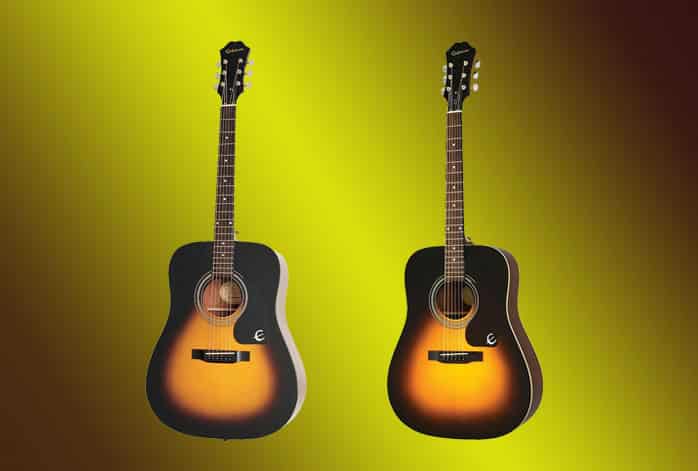Contents
Once it comes to acoustic guitars, Epiphone PR-150 vs DR-100 is a never-ending battle. Even though many have said that the DR-100 is the same as the PR-150, quite a few differences exist between these two guitars. In the case that you want to learn more about the guitars before deciding which one to get, you should find this article useful.
Epiphone PR-150
The classic guitar with great looks and tone, the PR-150 acoustic guitar is made with promising tonewoods – spruce top and mahogany body. Therefore, you can expect the guitar to have a balanced and clear sound. Vintage Sunburst finish gives the guitar that classy look, which makes it appear a bit expensive.
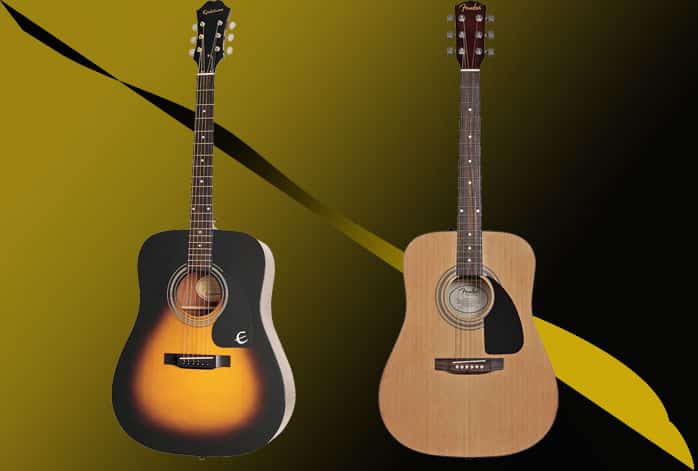
Epiphone DR-100
Another budget-friendly Vintage Sunburst guitar and may look like an expensive one is the Epiphone DR-100. It’s also made with a select spruce top and mahogany back and sides. Featuring a SlimTaper neck in which players – beginners and/or younger players, and even professionals – love the grip and fast play.
Specs Comparison
Both are great guitars with excellent build and a stunning finish, which means, it’ll be a challenge to distinguish without checking the labels. So, check for some of their significant specifications.
| EPIPHONE PR-150 | EPIPHONE DR-100 | |
| Body Shape | Dreadnought | Square Shoulder Dreadnought |
| Body Material | Spruce top; Mahogany back and sides | Select Spruce top with Mahogany body |
| Neck Shape | SlimTaper | SlimTaper™ C-profile |
| Neck Material | Mahogany | Mahogany |
| Scale Length | 25.5″ | 25.5″ / 647.7mm |
| Nut Width | 1.68″ | 1.69″ / 43mm |
| Fretboard Material | Rosewood with dot inlays | Rosewood with Pearloid Dot inlays |
| Fretboard Radius | 12″ radius | 12″ |
| Number of Frets | 20 | 20 medium jumbo frets |
| Hardware | Chrome | Chrome |
| Bridge | Rosewood bridge and synthetic bone saddle | Rosewood |
Both the Epiphone DR-100 and the PR-150 come with various finish options, but in this article, the Vintage Sunburst version is highlighted. For the DR-100, you can choose Natural or Ebony, while for the DR-150, you’ll have Natural or Wine Red.
These guitars are made of laminated wood, rather than solid wood. One advantage of laminated construction is that it’s less affected by humidity – great guitars if you’re always on the go. The vintage-style soundhole and tortoiseshell-style pickguard with the ’60s-era “E” logo seems to complete the classy look of these guitars.
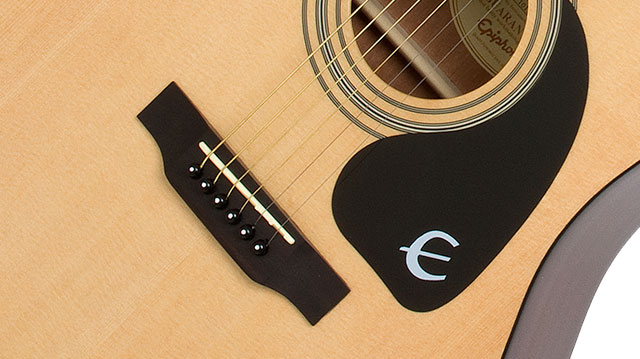
Playability
The SlimTaper C neck profile of these acoustic guitars – not-so-thin, not-so-thick – gives players the versatility to play a wide range of guitar styles. It’ll be very easy to move up and down the rosewood fretboard because of the flatter radius. And, in addition, bending and soloing with either of these guitars is just a breeze.
Speaking of the string action, DR-100 has the perfect action. With the PR-150, you’ll get a much higher action out-of-the-box. You can easily correct it, though, by sanding down the saddle. You can check this quick guide if you’re confident doing this yourself. Or, better yet, get a professional set up for your guitar to sure – it doesn’t cost that much.
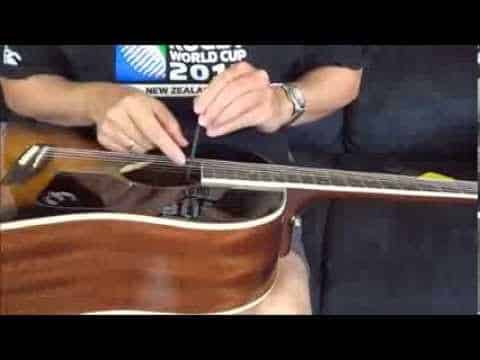
In general, the PR-150 is great for strumming, but may not be ideal for fingerpicking and single-note lines. The DR-100, on the other hand, is great for gentle fingerpicking and full strumming. Now, we’re getting a much clearer distinction of these dreadnoughts, even though they’re very identical.
Sound
Most guitarists know that a dreadnought guitar provides more bass response with elaborate projection. Since these guitars have big bodies, it’s capable of filling nearly any playing space.
PR-150 is known to achieve plenty of top-end because of the Spruce top, while warm low-end because of its mahogany body. In addition, this dreadnought delivers loud and full sound, which is also great when you’re camping or jamming outdoors.
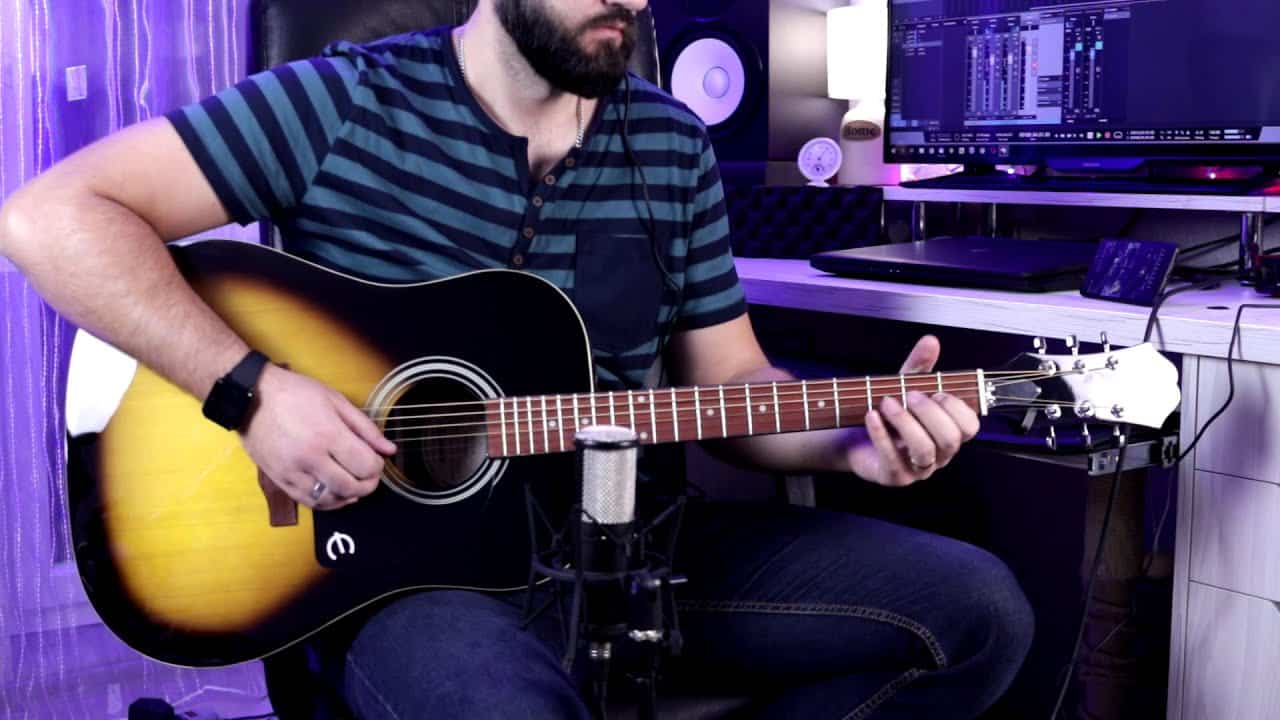
The Epiphone DR-100 has a thick and full sound distinct to a dreadnought. It has full bass with bell-like trebles. No issues with dead frets or string buzz, so you can play on and on without falter.
Lastly, the spruce top and mahogany body tandem is perfect for a classic sound. The balance and clarity of the sound will only get better and better the more you play these guitars.
Hardware
Though these are among the entry-level guitars from Epiphone, they didn’t cut corners in these guitars. In fact, you can find premium die-cast tuners on the DR-100. It has a synthetic nut and compensated synthetic saddle. These are just enough to get you started; you can easily update the nut to bone or tusq if you want to. The rosewood bridge is perfect to improve the longevity and strength of the guitar.
The Epiphone PR-150 has chrome hardware with chrome-plated sealed tuning machines with a good 14:1 ratio. Such tuners are ideal for making quick and incremental adjustments to your strings. Its nut seems to be cheap plastic, but it’s compensated with a synthetic bone saddle and Rosewood bridge. Still, if you really want to get the best of your PR-150, you can just upgrade the nut to your liking.
Price
The Epiphone DR-100 is the all-time highest-selling guitar between the two. This record tells us something – the DR-100 is a great dreadnought guitar for its price. The Epiphone PR-150 is slightly more expensive than the DR-100, but many are saying that the PR-150 is slightly better.
Conclusion
As can be seen from the specs comparison to the head-to-head contrast in terms of playability and sound, they seem to be neck-to-neck. There are bits of good stuff here and there, between Epiphone PR-150 vs DR-100.

The DR-100 can be a great beginner guitar, especially for those who want to transition to electric guitars. This is due to its very spot-on action. But you can quickly send the PR-150 to professional luthiers to correct its action, as well. The Epiphone PR-150 is a nice guitar, too. And, some guitarists even recommend this over the DR-100.
So, the deciding agent (YOU) will now get to choose which one you’ll get based on YOUR preferences.

Hi music fan! I am Jeff. Hope that you enjoy some stuff I shared here in my personal blog.
About myself, Currently I am in charging as Artist Manager/Music Supervisor at 72 Music Management. I did managed album to Grammy Award in 2017 with 7 Nominations from 2014-2020 and had the opportunities to work with : A.J. Croce, Blind Boys of Alabama, Bobby Rush, Dom Flemons, Dustbowl Revival, Sarah Grace
Governor of the Memphis Chapter of The Recording Academy is one of a award that I am lucky to achieved.
